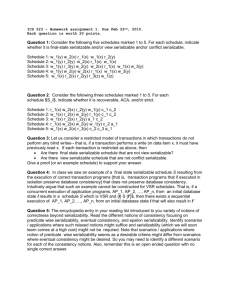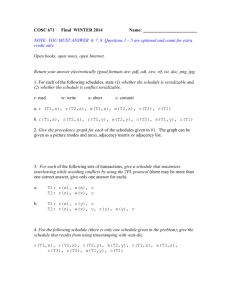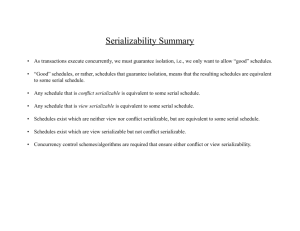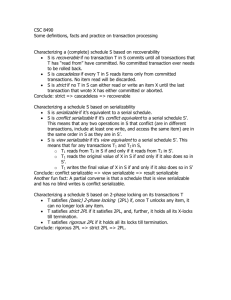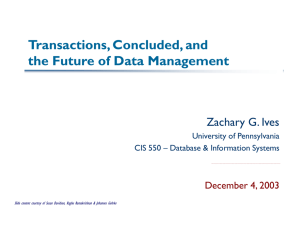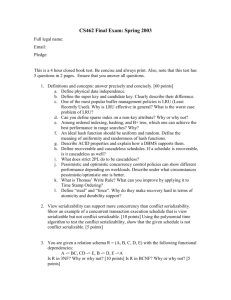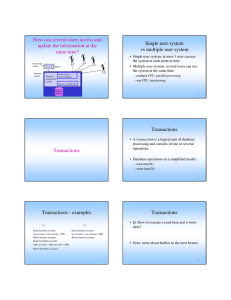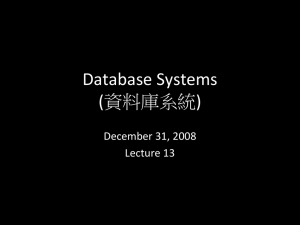Document
advertisement
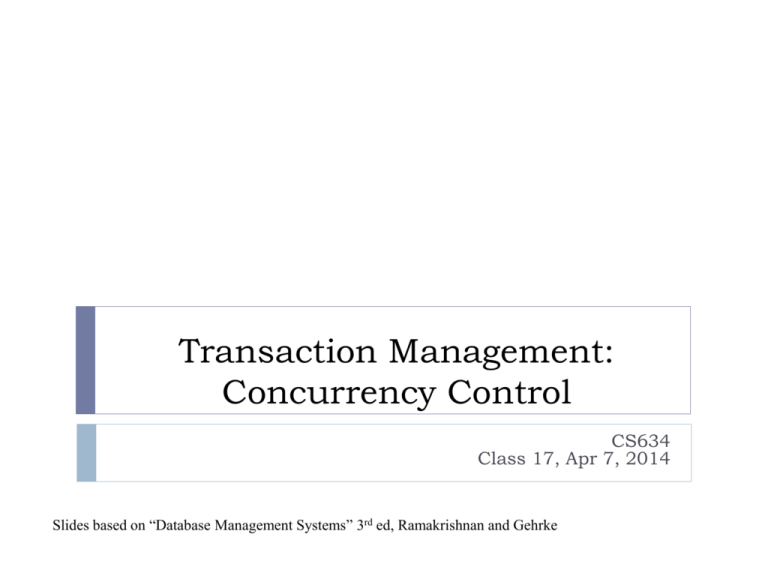
Transaction Management: Concurrency Control CS634 Class 17, Apr 7, 2014 Slides based on “Database Management Systems” 3rd ed, Ramakrishnan and Gehrke Modeling Transactions User programs may carry out many operations … Data modification and retrieval Prompting user for input … but the DBMS is only concerned about what data is read/written from/to the database A transaction is abstracted by a sequence of time-ordered read and write actions 2 e.g., R(X), R(Y), W(X), W(Y) R=read, W=write, data element in parentheses Each individual action is indivisible, or atomic SQL UPDATE = R(X) W(X) Concurrency: lost update anomaly Consider two transactions (in a really bad DB) where A = 100 T1: T2: A = A + 100 A = A + 100 T1 & T2 are concurrent, running same transaction program T1& T2 both read old value, 100, add 100, store 200 One of the updates has been lost! Consistency requirement: after execution, A should reflect all deposits (Money should not be created or destroyed) No guarantee that T1 will execute before T2 or vice-versa… … but the net effect must be equivalent to these two transactions running one-after-the-other in some order 3 Concurrency: more complex case (1/3) Consider two transactions running different programs T1: T2: A=A+100, B=B-100 A=1.06*A, B=1.06*B T1 performs an account transfer T2 performs credit of (6%) interest amount Consistency requirement: after execution, sum of accounts must be 106% the initial sum (before execution) No guarantee that T1 will execute before T2 or vice-versa… … but the net effect must be equivalent to these two transactions running one-after-the-other in some order 4 Concurrency: when things go wrong (2/3) Assume that initially there are $500 in both accounts Consider a possible interleaving or schedule T1: T2: A=A+100, A=1.06*A, B=B-100 B=1.06*B After execution, A=636, B=424, A+B=1060 CORRECT 5 Concurrency: when things go wrong (3/3) Consider another interleaving or schedule: T1: T2: A=A+100, A=1.06*A, B=1.06*B B=B-100 After execution, A=636, B=430, A+B=1066 WRONG!!! The DBMS view T1: T2: 6 R(A), W(A), R(A), W(A), R(B), W(B) R(B), W(B) Concurrent Execution Anomalies Anomalies may occur in concurrent execution The notion of conflicts helps understand anomalies Is there a conflict when multiple READ operations are posted? No What if one of the operations is a WRITE? YES! WR, RW and WW conflicts 7 WR Conflicts Reading Uncommitted Data (Dirty Reads) T1: T2: R(A), W(A), R(A), W(A), R(B), W(B) R(B), W(B) The earlier example where interest is not properly credited is due to a WR conflict Value of A written by T1 is read by T2 before T1 completed all its changes 8 RW Conflicts Unrepeatable Reads T1: T2: R(A), R(A), W(A), Commit R(A), W(A), Commit Scenario: Let A (=1) be the number of copies of an item. T1 checks the number available. If the number is greater than 0, T1 places an order by decrementing the count In the meantime, T2 updated the value of the count (say, to zero) T1 will set the count to a negative value! 9 WW Conflicts Overwriting Uncommitted Data T1: T2: W(A), W(B), Commit W(A), W(B), Commit Assume two employees must always have same salary T1 sets the salaries to $1000, T2 to $2000 There is a “lost update”, and the final salaries are $1000 and $2000 “Lost” update because the transaction that comes last in serial order should set both values. One got lost. 10 Scheduling Transactions Preventing anomalies: only allow some schedules to occur Disallow “unsafe” interleavings Serial schedule: no interleaving of transactions Safe, but poor performance! Schedule equivalence: two schedules are equivalent if they lead to the same state of the DBMS (see footnote on pg. 525 that includes values returned to user in relevant ”state”) Serializable schedule: schedule that is equivalent to some serial execution of transactions But still allows interleaving/concurrency! 11 Serializable schedule example T1: T2: A=A+100, A=1.06*A, B=B-100 B=1.06*B Same effect as executing T1 completely, then T2 12 Conflict Serializable Schedules Two schedules are conflict equivalent if: Involve the same actions of the same transactions Every pair of conflicting actions is ordered the same way Schedule S is conflict serializable if S is conflict equivalent to some serial schedule Dependency Graph Dependency graph: one node per transaction edge from Ti to Tj if action of Ti precedes and conflicts with action of Tj Theorem: Schedule is conflict serializable if and only if its dependency graph is acyclic Equivalent serial schedule given by topological sort of dependency graph Example A schedule that is not conflict serializable: T1: T2: R(A), W(A), R(B), W(B) R(A), W(A), R(B), W(B) A T1 T2 Dependency graph B The cycle in the graph reveals the problem. The output of T1 depends on T2, and vice-versa. Why is serializability important? If each transaction preserves consistency, every serializable schedule preserves consistency How to ensure serializable schedules? Use locking protocols DBMS inserts proper locking actions, user is oblivious to locking (except through its effect on performance, and deadlocks) 16 Strict Two-Phase Locking (Strict 2PL) Protocol steps Each transaction must obtain a S (shared) lock on object before reading, and an X (exclusive) lock on object before writing. All locks held are released when the transaction completes (Non-strict) 2PL: Release locks anytime, but cannot acquire locks after releasing any lock. Strict 2PL allows only serializable schedules. It simplifies transaction aborts (Non-strict) 2PL also allows only serializable schedules, but involves more complex abort processing 19 Strict 2PL Example (red op is blocked) S(B) T1: S(A) R(A) T2: S(A) R(A) X(B) S(B) T1: S(A) R(A) T2: S(A) R(A) X(B) R(B) S(B) T1: S(A) R(A) T2: S(A) R(A) X(B) R(B) W(B) C S(B) R(B) C T1: S(A) R(A) T2: S(A) R(A) X(B) R(B) W(B) C 20 Aborting Transactions When Ti is aborted, all its actions have to be undone if Tj reads an object last written by Ti, Tj must be aborted as well! cascading aborts can be avoided by releasing locks only at commit If Ti writes an object, Tj can read this only after Ti commits In Strict 2PL, cascading aborts are prevented At the cost of decreased concurrency No free lunch! Increased parallelism leads to locking protocol complexity 21 View Serializability (1/3) Conflict serializability is sufficient, but not necessary! Schedules S1 and S2 are view equivalent if: If Ti reads initial value of A in S1, then Ti also reads initial value of A in S2 If Ti reads value of A written by Tj in S1, then Ti also reads value of A written by Tj in S2 If Ti writes final value of A in S1, then Ti also writes final value of A in S2 Same “reads-from” graph View serializability is a more general sufficient condition View Serializability (2/3) An Example Non-conflict serializable T1: R(A) W(A) T2: W(A) T3: W(A) Equivalent serial schedule T1: R(A),W(A) T2: W(A) T3: W(A) View Serializability (3/3) A schedule is view serializable if it is view equivalent to a serial schedule. Every conflict serializable schedule is view serializable. The converse is not true. Every view serializable schedule that is not conflict serializable contains a blind write. Unfortunately, testing is not practical Only of theoretical interest Deadlocks Cycle of transactions waiting for locks to be released by each other T1: T2: X(A) W(A) S(B) [R(B) …] X(B) W(B) S(A) [R(A) …] Two ways of dealing with deadlocks: 25 Deadlock prevention Deadlock detection Deadlock Detection Create a waits-for graph: Nodes are transactions Edge from Ti to Tj if Ti is waiting for Tj to release a lock T1: S(A), R(A), S(B) T2: X(B),W(B) X(C) X(A) T3: S(C), R(C) T4: X(B) 26 T1 T2 T4 T3 Deadlock Prevention Assign priorities based on timestamps Assume Ti wants a lock that Tj holds Wait-Die: It Ti > Tj, Ti waits for Tj; otherwise Ti aborts Wound-wait: If Ti > Tj, Tj aborts; otherwise Ti waits Fairness is an issue 27 If transaction re-starts, make sure it has its original timestamp Otherwise starvation may occur Locking Performance Lock-based schemes rely on two mechanisms Both blocking and aborting cause performance overhead Blocking Aborting Transactions may have to wait Transactions may need to be re-executed How does blocking affect throughput? First few transactions do not conflict – no blocking Parallel execution, performance increase As more transactions execute, blocking occurs After a point, adding more transactions decreases throughput! Locking Performance (2) Thrashing Active Transaction Count Improving Performance Locking the smallest-sized objects possible Reduce the time a lock is held for e.g., row set instead of table Release locks faster But careful not to cause too many cascaded aborts Reducing hot spots Careful review of application design Reduce contention Lock Management Lock and unlock requests are handled by the lock manager Lock table entry: Number of transactions currently holding a lock Type of lock held (shared or exclusive) Pointer to queue of lock requests Locking and unlocking have to be atomic operations
